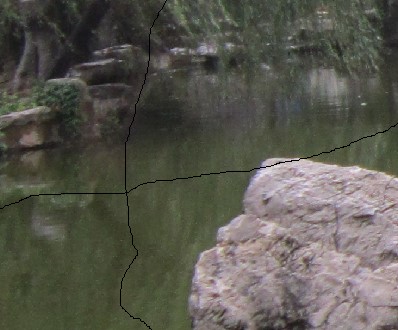HDU 5092 Seam Carving (DP+打印路径)
来源:互联网 发布:淘宝装修平台 编辑:程序博客网 时间:2024/06/05 12:39
Seam Carving
Time Limit: 2000/1000 MS (Java/Others) Memory Limit: 65536/65536 K (Java/Others)
Total Submission(s): 1355 Accepted Submission(s): 534
Problem Description
Fish likes to take photo with his friends. Several days ago, he found that some pictures of him were damaged. The trouble is that there are some seams across the pictures. So he tried to repair these pictures. He scanned these pictures and stored them in his computer. He knew it is an effective way to carve the seams of the images He only knew that there is optical energy in every pixel. He learns the following principle of seam carving. Here seam carving refers to delete through horizontal or vertical line of pixels across the whole image to achieve image scaling effect. In order to maintain the characteristics of the image pixels to delete the importance of the image lines must be weakest. The importance of the pixel lines is determined in accordance with the type of scene images of different energy content. That is, the place with the more energy and the richer texture of the image should be retained. So the horizontal and vertical lines having the lowest energy are the object of inspection. By constantly deleting the low-energy line it can repair the image as the original scene.

For an original image G of m*n, where m and n are the row and column of the image respectively. Fish obtained the corresponding energy matrix A. He knew every time a seam with the lowest energy should be carved. That is, the line with the lowest sum of energy passing through the pixels along the line, which is a 8-connected path vertically or horizontally.
Here your task is to carve a pixel from the first row to the final row along the seam. We call such seam a vertical seam.

For an original image G of m*n, where m and n are the row and column of the image respectively. Fish obtained the corresponding energy matrix A. He knew every time a seam with the lowest energy should be carved. That is, the line with the lowest sum of energy passing through the pixels along the line, which is a 8-connected path vertically or horizontally.
Here your task is to carve a pixel from the first row to the final row along the seam. We call such seam a vertical seam.
Input
There several test cases. The first line of the input is an integer T, which is the number of test cases, 0<T<=30. Each case begins with two integers m, n, which are the row and column of the energy matrix of an image, (0<m,n<=100). Then on the next m line, there n integers.
Output
For each test case, print “Case #” on the first line, where # is the order number of the test case (starting with 1). Then print the column numbers of the energy matrix from the top to the bottom on the second line. If there are more than one such seams, just print the column number of the rightmost seam.
Sample Input
24 355 32 7517 69 7354 81 6347 5 456 651 57 49 65 50 7433 16 62 68 48 612 49 76 33 32 7823 68 62 37 69 3968 59 77 77 96 5931 88 63 79 32 34
Sample Output
Case 12 1 1 2Case 23 2 1 1 2 1
Source
2014上海全国邀请赛——题目重现(感谢上海大学提供题目)
题意:给出一个mxn的矩阵,每个格子有对应权值,现在从第一行到最后一行需要找到一条经过权值最小的路径,且打印出每行选择的列的编号。如果有多列满足条件,则打印最右的列的编号。
思路:DP方程很好推,即数塔的改良版,重点在打印路径上,之前就不太会打印路径,这次也是看了别人的实现才会。
#include <iostream>#include <string.h>#include <algorithm>#include <stdio.h>using namespace std;long long dp[105][105];long long a[105][105];long long path[105][105];#define INF 999999999void print(int num,int index){ if(path[num][index]==-1){ printf("%d ",index); return ; } else{ print(num-1,path[num][index]); printf("%d ",index); }}int main(){int t;freopen("data.txt","r",stdin);scanf("%d",&t);for(int cas=1;cas<=t;cas++){int n,m;memset(path,-1,sizeof(path));scanf("%d %d",&n,&m);for(int i=1;i<=n;i++){for(int j=1;j<=m;j++){scanf("%lld",&a[i][j]);dp[i][j]=INF;}} for(int i=1;i<=m;i++)dp[1][i]=a[1][i];printf("Case %d\n",cas);for(int i=2;i<=n;i++){for(int j=1;j<=m;j++){if(j!=1&&dp[i][j]>dp[i-1][j-1]+a[i][j]){ dp[i][j]=dp[i-1][j-1]+a[i][j]; path[i][j]=j-1;}if(dp[i][j]>=dp[i-1][j]+a[i][j]){ dp[i][j]=dp[i-1][j]+a[i][j]; path[i][j]=j;}if(j!=m&&dp[i][j]>=dp[i-1][j+1]+a[i][j]){ dp[i][j]=dp[i-1][j+1]+a[i][j]; path[i][j]=j+1;}}}long long min_x=INF;int u=0;for(int i=m;i>=1;i--){ if(dp[n][i]<min_x){ min_x=dp[n][i]; u=i; }}print(n-1,path[n][u]);printf("%d\n",u);}return 0;} 0 0
- HDU 5092 Seam Carving (DP+打印路径)
- HDU 5092 Seam Carving(DP, 路径)
- hdu 5092 Seam Carving dp+记录路径
- hdu 5092 Seam Carving(DP+记录路径)
- Hdu 5092 Seam Carving(dp)
- HDU 5092 Seam Carving(DP)
- hdu5092 Seam Carving(dp 打印路径)
- 【DP】 HDU 5092 Seam Carving
- hdu 5092 Seam Carving(dp)
- HDU 5092 Seam Carving DP
- HDU 5092 Seam Carving(上海邀请赛基础DP)
- hdu 5092 Seam Carving
- hdu 5092 Seam Carving
- HDU 5092 Seam Carving
- HDU 5092 Seam Carving
- HDOJ 5092 Seam Carving DP
- HDOJ 5092 Seam Carving(动态规划,回溯,记录路径)
- HDU 5092 Seam Carving 递推
- ssdb
- mysql下如何执行sql脚本
- spring 代码中,解决docker环境变量传递问题
- java程序运行
- const
- HDU 5092 Seam Carving (DP+打印路径)
- BFC规范
- 最小生成树——普里姆算法(Prim)和克鲁斯卡尔算法(Kruskal)
- 【HDU2196】【树形DP】
- 运放的轨到轨与偏置电压
- Android6.0存储中加入总内存和系统内存项和在西语下把,换成.
- 初次做二叉树的题目--给定中序和前序求后序
- 【GDOI2017模拟11.2】相位幻击
- 自定义饼状图


